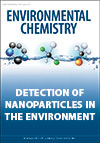
Environmental Chemistry
Volume 11 Number 4 2014
RESEARCH FRONT: Detection of Nanoparticles in the Environment
EN14037Current status and future direction for examining engineered nanoparticles in natural systems
Environmental context. The detection and characterisation of engineered nanomaterials in the environment is essential for exposure and risk assessment for this emerging class of materials. However, the ubiquitous presence of naturally occurring nanomaterials presents a unique challenge for the accurate determination of engineered nanomaterials in environmental matrices. New techniques and methodologies are being developed to overcome some of these issues by taking advantage of subtle differences in the elemental and isotopic ratios within these nanomaterials.
EN13182In situ characterisation of physicochemical state and concentration of nanoparticles in soil ecotoxicity studies using environmental scanning electron microscopy
Environmental context. Characterisation of nanoparticles in terms of number concentration and aggregation state is essential for interpreting data from toxicological tests. These parameters have never been measured in situ in tests carried out in soil matrices. Here, environmental scanning electron microscopy imaging is evaluated for particles in soil, and a method for determining the number concentrations by counting the particles in the images is developed.
EN13184Observations and assessment of iron oxide and green rust nanoparticles in metal-polluted mine drainage within a steep redox gradient
Environmental context. Legacy contamination from mining operations is a serious and complex environmental problem. We examine a former uranium mine where groundwater leaving the site enters a stream with chemically dramatic effects resulting in a fundamental change in the way contaminant metals are transported to the surface environment. The results are important for our understanding of how these contaminants are dispersed, and how they could interact with the biosphere.
EN13232Separation, detection and characterisation of engineered nanoparticles in natural waters using hydrodynamic chromatography and multi-method detection (light scattering, analytical ultracentrifugation and single particle ICP-MS)
Environmental context. The effects of engineered nanoparticles on the environment and on human health are difficult to evaluate largely because nanoparticles are so difficult to measure. The main problems are that concentrations are low and the engineered nanoparticles are often difficult to distinguish from the environmental matrices in which they are found. We report a separation technique that facilitates the detection of engineered nanoparticles in natural waters.
EN13232 Abstract | EN13232 Full Text | EN13232PDF (603 KB) | EN13232Supplementary Material (1.4 MB) Open Access Article
EN14072A pilot interlaboratory comparison of protocols that simulate aging of nanocomposites and detect released fragments
Environmental context. Nanoparticles are contained in many commercialised products, but the lack of validated methods to assess their potential release into the environment hampers our ability to perform a reliable risk assessment. Equipment to simulate aging is available, but the challenge is to sample released entities, and to analyse those fragments with suitable nano-analytics. We describe methods to characterise the degradation and surface accumulation of nanoparticles, and to quantify fragments released during UV irradiation of polymer nanocomposites.
EN14064The persistence and transformation of silver nanoparticles in littoral lake mesocosms monitored using various analytical techniques
Environmental context. Silver nanoparticles discharged with municipal wastewater may contaminate surface waters and harm aquatic ecosystems. We applied several analytical techniques to investigate the persistence and transformation of silver nanoparticles in a natural lake environment, and show, through multiple lines of evidence, that they persisted in lake water for several weeks after addition. The nanoparticles were releasing silver ions through dissolution, but these toxic ions were likely binding with natural organic matter in the lake water.
EN13218Recalcitrant pharmaceuticals in the aquatic environment: a comparative screening study of their occurrence, formation of phototransformation products and their in vitro toxicity
Environmental context. Many pharmaceuticals on the market have not undergone detailed evaluation for potential aquatic toxicity. We found that most tested pharmaceuticals were persistent, that phototransformation products were likely to be formed as a result of UV treatment of wastewater and that some transformation products were more toxic to bacteria than their precursor pharmaceutical compound. Thus UV treatment of wastewater does not seem appropriate to completely degrade or transform micropollutants into harmless compounds.
EN13218 Abstract | EN13218 Full Text | EN13218PDF (592 KB) | EN13218Supplementary Material (603 KB) Open Access Article
EN13150The effect of anthropogenic volatile organic compound sources on ozone in Boise, Idaho
Environmental context. Volatile organic compounds are precursors of ozone, a pollutant with adverse environmental effects. It is important to determine the associations between the various sources of volatile organic compounds and ozone levels because emission controls are based on sources. We estimated the contributions of specific sources of volatile organic compounds on ozone levels using both measurements and statistical models, and found that traffic is the largest source even in events when wildfire smoke is present.
EN13227Investigating the photo-oxidative and heterogeneous chemical production of HCHO in the snowpack at the South Pole, Antarctica
Snowpacks present a surprisingly active environment for photochemistry, leading to sunlight-induced oxidation of deposited organic matter and the subsequent emission of a variety of photochemically active trace gases. We seek to address questions regarding the ultimate fate of organic matter deposited onto snow in the remote regions of the world. The work is relevant to atmospheric composition and climate change.
EN13227 Abstract | EN13227 Full Text | EN13227PDF (618 KB) Open Access Article
EN14060Analysis of soil organic matter at the solid–water interface by nuclear magnetic resonance spectroscopy
Environmental context. Structural and conformational information on organic matter–clay complexes and whole soils was obtained using different NMR methods. The results show that organic matter interactions with clay mineral surfaces determine the accessibility of specific organic matter components at the soil–water interface. This physical conformation may also play a role in soil biogeochemical processes and binding to pollutants in terrestrial environments.



